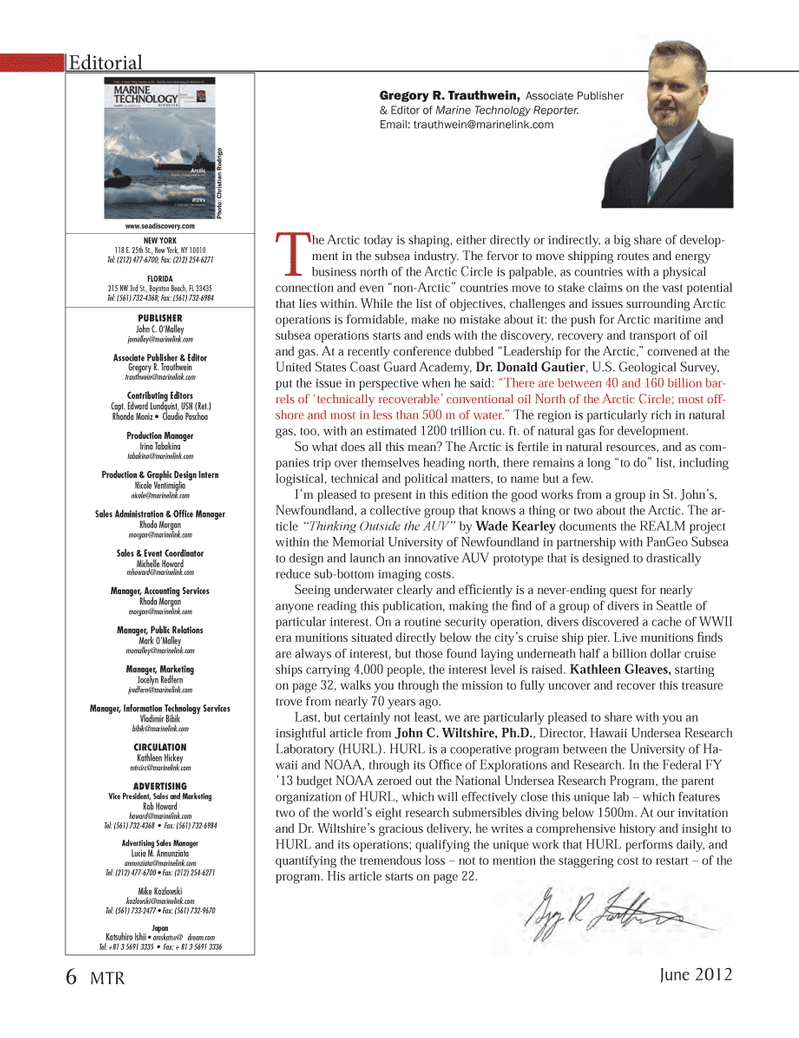
Page 6: of Marine Technology Magazine (June 2012)
AUV Arctic Operations
Read this page in Pdf, Flash or Html5 edition of June 2012 Marine Technology Magazine
Editorial www.seadiscovery.com NEW YORK118 E. 25th St., New York, NY 10010 Tel: (212) 477-6700; Fax: (212) 254-6271 FLORIDA215 NW 3rd St., Boynton Beach, FL 33435Tel: (561) 732-4368; Fax: (561) 732-6984 PUBLISHER John C. [email protected] Publisher & EditorGregory R. Trauthwein [email protected] Editors Capt. Edward Lundquist, USN (Ret.) Rhonda Moniz Claudio PaschoaProduction ManagerIrina Tabakina [email protected] & Graphic Design InternNicole Ventimiglia [email protected] Administration & OfÞ ce Manager Rhoda [email protected] & Event Coordinator Michelle Howard [email protected], Accounting Services Rhoda Morgan [email protected], Public Relations Mark [email protected], Marketing Jocelyn [email protected], Information Technology Services Vladimir [email protected] Kathleen [email protected] Vice President, Sales and MarketingRob [email protected]: (561) 732-4368 Fax: (561) 732-6984 Advertising Sales Manager Lucia M. [email protected]: (212) 477-6700 Fax: (212) 254-6271 Mike [email protected]: (561) 733-2477 Fax: (561) 732-9670 JapanKatsuhiro Ishii amskatsu@ dream.comTel: +81 3 5691 3335 Fax: + 81 3 5691 3336 Gregory R. Trauthwein, Associate Publisher & Editor of Marine Technology Reporter. Email: [email protected] The Arctic today is shaping, either directly or indirectly, a big share of develop- ment in the subsea industry. The fervor to move shipping routes and energy business north of the Arctic Circle is palpable, as countries with a physical connection and even ?non-Arctic? countries move to stake claims on the vast potential that lies within. While the list of objectives, challenges and issues surrounding Arctic operations is formidable, make no mistake about it: the push for Arctic maritime and subsea operations starts and ends with the discovery, recovery and transport of oil and gas. At a recently conference dubbed ?Leadership for the Arctic,? convened at the United States Coast Guard Academy, Dr. Donald Gautier , U.S. Geological Survey, put the issue in perspective when he said: ?There are between 40 and 160 billion bar- rels of ?technically recoverable? conventional oil North of the Arctic Circle; most off- shore and most in less than 500 m of water.? The region is particularly rich in natural gas, too, with an estimated 1200 trillion cu. ft. of natural gas for development. So what does all this mean? The Arctic is fertile in natural resources, and as com- panies trip over themselves heading north, there remains a long ?to do? list, including logistical, technical and political matters, to name but a few. I?m pleased to present in this edition the good works from a group in St. John?s, Newfoundland, a collective group that knows a thing or two about the Arctic. The ar- ticle ?Thinking Outside the AUV? by Wade Kearley documents the REALM project within the Memorial University of Newfoundland in partnership with PanGeo Subsea to design and launch an innovative AUV prototype that is designed to drastically reduce sub-bottom imaging costs.Seeing underwater clearly and ef ciently is a never-ending quest for nearly anyone reading this publication, making the nd of a group of divers in Seattle of particular interest. On a routine security operation, divers discovered a cache of WWII era munitions situated directly below the city?s cruise ship pier. Live munitions nds are always of interest, but those found laying underneath half a billion dollar cruise ships carrying 4,000 people, the interest level is raised. Kathleen Gleaves, starting on page 32, walks you through the mission to fully uncover and recover this treasure trove from nearly 70 years ago. Last, but certainly not least, we are particularly pleased to share with you an insightful article from John C. Wiltshire, Ph.D. , Director, Hawaii Undersea Research Laboratory (HURL). HURL is a cooperative program between the University of Ha- waii and NOAA, through its Of ce of Explorations and Research. In the Federal FY ?13 budget NOAA zeroed out the National Undersea Research Program, the parent organization of HURL, which will effectively close this unique lab ? which features two of the world?s eight research submersibles diving below 1500m. At our invitation and Dr. Wiltshire?s gracious delivery, he writes a comprehensive history and insight to HURL and its operations; qualifying the unique work that HURL performs daily, and quantifying the tremendous loss ? not to mention the staggering cost to restart ? of the program. His article starts on page 22.June 20126 MTRPhoto: Christian Rodrigo MTR #5 (1-17).indd 6MTR #5 (1-17).indd 66/1/2012 1:36:53 PM6/1/2012 1:36:53 PM

 5
5

 7
7
